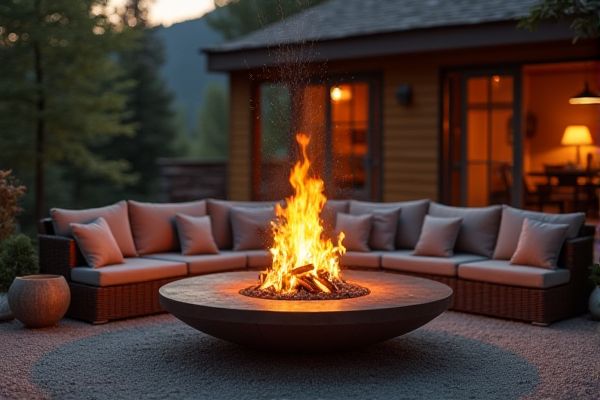
A fire pit offers a traditional, open flame ambiance ideal for outdoor gatherings, while a table heater provides focused, consistent warmth with a sleek design perfect for intimate settings. To explore which option best suits Your outdoor comfort needs, read on for a detailed comparison.
Table of Comparison
| Feature | Fire Pit | Table Heater |
|---|---|---|
| Heat Source | Wood, Gas, or Propane Flames | Electric or Propane Heating Element |
| Heat Output | High, Radiant Heat Suitable for Outdoor | Moderate, Focused Heat for Small Areas |
| Design | Open Flame with Rustic or Modern Styles | Compact, Tabletop with Minimal Flame |
| Usage | Outdoor Patios, Backyard Gatherings | Outdoor Dining, Small Group Settings |
| Safety | Requires Supervision Due to Open Flames | Safer with Controlled Heat and Flame |
| Fuel Type | Wood, Gas, or Propane | Electric or Propane |
| Portability | Varies; Some Portable, Some Fixed | Highly Portable and Lightweight |
| Maintenance | Requires Cleaning of Ash or Gas Lines | Minimal Maintenance Required |
| Cost Range | $100 - $1000+ | $50 - $500 |
Introduction to Fire Pit and Table Heater
Fire pits offer an open flame experience that combines warmth and ambiance, often fueled by wood, propane, or natural gas, making them ideal for outdoor gatherings. Table heaters provide a more compact and controlled heat source, typically powered by propane or electricity, designed to fit on tabletops for intimate spaces. Both options enhance outdoor comfort but cater to different needs in heat output, portability, and aesthetic appeal.
Design and Aesthetics Comparison
Fire pits often feature rustic, natural designs with open flames that create a cozy, inviting atmosphere, making them ideal for outdoor social gatherings. Table heaters typically exhibit sleek, modern aesthetics with enclosed flames or heating elements, seamlessly blending into contemporary patio setups. Your choice depends on whether you prefer the traditional charm of a fire pit or the minimalist elegance of a table heater to complement your outdoor space.
Heat Output and Coverage Area
Fire pits generally provide higher heat output, often ranging from 30,000 to 100,000 BTUs, making them suitable for larger outdoor areas up to 300 square feet. Table heaters typically offer lower heat output, around 5,000 to 15,000 BTUs, best for small gatherings around a dining table covering about 20 to 40 square feet. Choosing between the two depends on your desired warmth level and the size of your outdoor space, ensuring efficient heat coverage for comfort.
Fuel Types and Efficiency
Fire pits typically use wood or propane as fuel, offering a traditional ambiance with varying burn times depending on wood quality or tank size, while table heaters predominantly run on propane or natural gas, providing consistent and easily adjustable heat. Propane-fueled table heaters tend to be more efficient, converting fuel into warmth with minimal waste and producing less smoke compared to wood fire pits. Your choice depends on whether you prioritize the rustic charm and aroma of wood or the steady, efficient heat output of gas-powered table heaters.
Safety Features and Precautions
Fire pits often include safety features such as spark guards and cool-touch handles to prevent accidental burns, but they require careful placement away from flammable materials and constant supervision. Table heaters typically have built-in tip-over protection and automatic shut-off mechanisms, enhancing safety for indoor or enclosed spaces. When choosing between the two, your safety can be maximized by considering the location, ensuring proper ventilation, and following manufacturer guidelines for use and maintenance.
Ease of Installation and Portability
Fire pits typically require more installation effort due to their size and need for a stable, heat-resistant surface, making them less portable than table heaters. Table heaters are designed for easy setup with lightweight materials and compact designs, allowing effortless relocation and quick assembly. Portability makes table heaters ideal for small spaces and on-the-go use, whereas fire pits are better suited for permanent outdoor installations.
Maintenance Requirements
Fire pits demand regular cleaning of ash and debris to maintain functionality and safety, along with periodic inspection of gas lines or propane tanks in gas models. Table heaters require less frequent upkeep, mainly involving dusting and occasional checking of the ignition system and fuel canisters. Both devices benefit from coverage or storage during off-seasons to extend their lifespan and performance.
Cost Analysis: Initial and Ongoing Expenses
Fire pits generally have a lower initial cost compared to table heaters, with prices starting as low as $100, while table heaters typically begin around $150 due to their complex design and materials. Ongoing expenses for fire pits include wood or propane fuel, averaging $20-$40 monthly, whereas table heaters mainly rely on propane gas refills costing about $30-$50 per month depending on usage. Your decision should factor in both upfront investments and recurring fuel costs to determine which option offers the best value for your outdoor heating needs.
Environmental Impact Considerations
Fire pits typically consume wood or propane, releasing higher levels of carbon dioxide and particulate matter compared to table heaters, which often use cleaner energy sources like electricity or natural gas. Table heaters produce fewer emissions and are generally more energy-efficient, reducing their environmental footprint. Choosing electric table heaters powered by renewable energy further minimizes ecological impact compared to traditional fire pits.
Best Use Cases for Each Option
Fire pits excel in outdoor social gatherings, providing a cozy focal point and ample heat for group settings such as backyard parties or camping trips. Table heaters are ideal for smaller, intimate spaces like patios or balconies, offering targeted warmth while serving as functional furniture. Selecting between the two depends on the size of the area and the type of outdoor activity planned.
 homyna.com
homyna.com